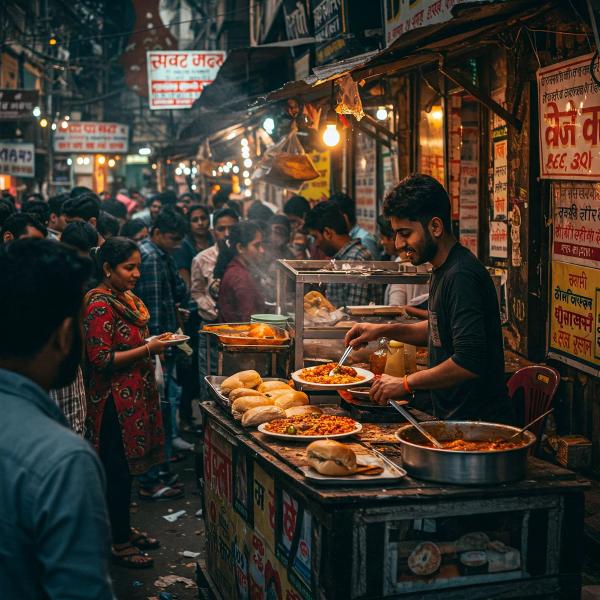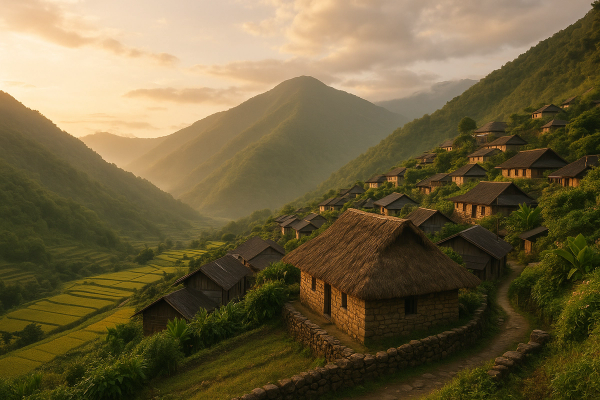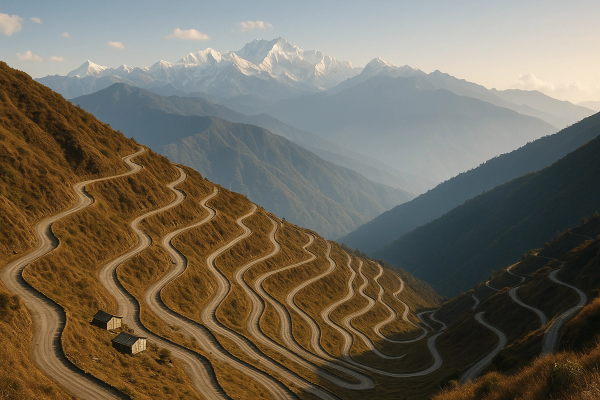
The Great Ocean Road, Man... You Gotta Do It.#
Okay, lemme tell ya about the Great Ocean Road. If you're heading to Australia, specifically the Melbourne area (Victoria, that is), people are gonna tell you about this drive. And honestly? They're right. It’s one of those iconic Australia road trips for a reason. I’d seen the pictures, you know, the famous rock stacks? But driving it yourself… yeah, it hits different. This isn't just about getting from A to B; it's about the salty air, the ridiculously blue water, the winding roads, and kinda feeling like you’re in a car commercial half the time. Prepare for some serious coastal eye-candy.¶
So, buckle up! I'm gonna break down my Great Ocean Road travel experience – the good bits, the slightly less glamorous bits (like nearly running out of petrol, whoops), and hopefully give you enough info to plan your own epic adventure along one of the best scenic drives Australia has to offer. We're talkin' beaches, cliffs, wildlife... the works.¶
So, What Actually Is the Great Ocean Road?#
Right, basics first. The Great Ocean Road isn't just some random coastal highway. It's actually the world's largest war memorial, built by returned soldiers between 1919 and 1932 to honour those killed in World War I. Kinda puts things in perspective when you're cruising along, doesn't it? It stretches for about 243 kilometers (that's roughly 151 miles) along the southeastern coast of Australia, starting near Torquay (just southwest of Melbourne) and finishing up near Allansford. It snakes along the coast, sometimes dipping inland through forests, but mostly? Mostly it’s about those views.¶
It’s proper famous, known for dramatic limestone cliffs carved by the wild Southern Ocean, surf beaches, and pockets of rainforest. Definitely lives up to the hype, IMO.
When Should You Go? Timing is Kinda Key#
Okay, real talk: timing matters. Australia’s seasons are opposite to the Northern Hemisphere, remember that!¶
Summer (Dec - Feb): Peak Season Madness#
This is Aussie summer. Hot weather, great for beaches, but MAN, it gets crowded. Like, really crowded. Accommodation prices shoot up, and finding parking at the main spots (looking at you, Twelve Apostles) can be a nightmare. I went once in late January and swore... well, let's just say I preferred a different season. Good vibes if you love crowds, though!¶
- Pro: Best beach weather, buzzing atmosphere in towns like Lorne.
- Con: Heaps of people, expensive, parking struggles.
Autumn (Mar - May): The Sweet Spot? Maybe!#
This is arguably the best time. Weather's usually still pretty mild, fewer crowds than summer, and the scenery gets this lovely golden hue. I did a trip in April and it was chef's kiss. Still needed a jacket sometimes, but mostly sunny days and way more breathing room.¶
- Pro: Pleasant weather, fewer crowds, decent prices.
- Con: Can get occasional rain, evenings are cooler.
Winter (Jun - Aug): Moody & Majestic#
Okay, it's gonna be cold. And probably rainy. But! The coastline looks incredibly dramatic with big waves crashing, waterfalls are flowing strong in the Otways, and you'll practically have some spots to yourself. Plus, cheaper accommodation! And whale watching season kicks off around June/July. Just pack serious layers.¶
- Pro: Fewest crowds, dramatic scenery, lower prices, whale sightings (sometimes!).
- Con: Cold, wet weather likely, some tours might not run.
Spring (Sep - Nov): Warming Up, Getting Greener#
Things start warming up, wildflowers pop out in the national parks, and it's generally lovely. Still less crowded than summer, but can get busier towards November. Weather can be a bit unpredictable – sunny one minute, showers the next. Pretty standard Victoria travel tbh.¶
- Pro: Wildflowers, warming weather, moderate crowds.
- Con: Weather can be changeable.
My pick? Honestly, Autumn (April/May) felt like the best balance. But if you don't mind rugging up, Winter has a certain wild charm.
Getting There & Driving This Beast#
Most people start from Melbourne. It's about a 90-minute drive down the freeway to Torquay, the official start point. You absolutely, 100% need a car. Like, non-negotiable unless you're doing a bus tour (which... okay, it's an option, but you lose all the freedom).¶
Renting a Car#
Easy enough to rent from Melbourne Airport (MEL) or the city. Book ahead, especially in peak season. Remember, Aussies drive on the left! This is super important if you're not used to it. Take it easy, especially on the winding sections.¶
- Get full insurance. Seriously. Peace of mind is worth it.
- Automatic is probably easier if you're not used to shifting with your left hand.
- GPS is helpful, but download offline maps too. Phone service can be patchy.
The Drive Itself#
The road is well-maintained but it's very windy between Lorne and Apollo Bay. Like, very windy. Don't rush. Pull over ONLY in designated lookout spots or towns – don't just stop on the side of the road, it's dangerous.¶
Pro Tip: Drive it from Torquay towards Warrnambool (East to West). This keeps you on the ocean side of the road for the best views and makes pulling into lookouts easier (since you're not crossing traffic). Trust me on this one.
Where to Crash Along the Way#
You can technically drive it in a day, but WHY would you do that?! You need at least one overnight stop, ideally two or three, to actually enjoy it. Accommodation ranges from campsites and hostels to motels, Airbnbs, and fancier boutique hotels.¶
Key Towns to Consider:#
- Torquay: Surf capital, start of the road. Good spot for the first night if you leave Melbourne late.
- Lorne: Popular, bustling beach town. Lots of cafes, shops, bit more upscale vibe. Can get pricey.
- Apollo Bay: More relaxed, halfway point kinda. Good base for exploring the Otways. Plenty of accommodation options.
- Port Campbell: Tiny town right near the main attractions (Twelve Apostles, Loch Ard Gorge). Perfect for catching sunset/sunrise there. Accommodation is limited, so book ahead!
I stayed in Apollo Bay once at a simple motel, and another time splurged a bit near Port Campbell for easy sunrise access to the Apostles. Both worked well depending on the budget and plan.
The Main Event: What You Gotta See & Do#
Alright, the juicy stuff. There are SO many lookouts and stops. Don't feel like you have to hit every single one. Pick your battles!¶
The Big Hitters (East to West):#
- Bells Beach (near Torquay): Famous surf beach. Worth a quick look even if you don't surf.
- Split Point Lighthouse (Aireys Inlet): Cute lighthouse, you might recognise it from the kids' show 'Round the Twist' lol. Nice views.
- Memorial Arch: Obligatory photo stop! Marks the official start.
- Lorne & Erskine Falls: Lorne is great for lunch. Erskine Falls nearby is beautiful, requires a short walk down steps.
- Kennett River: THE spot to (hopefully) see koalas in the wild. Cruise slowly down Grey River Road off the main highway, looking up into the eucalyptus trees. Be patient! (And respectful, obvs). I saw like, 5 last time! Score!
- Apollo Bay: Chill town, good place to grab supplies or stay overnight.
- Cape Otway Lightstation: Australia's oldest working lighthouse. Costs $$ to enter the precinct, but cool history.
- Great Otway National Park: Detour inland for rainforest walks, waterfalls (Triplet Falls, Hopetoun Falls), and the Otway Fly Treetop Adventures (ziplining/treetop walk - costs extra).
- The Twelve Apostles: THE icon. Absolutely stunning, especially at sunrise or sunset. Prepare for crowds. There are multiple viewing platforms. Helicopter rides are available if you're feeling fancy (and rich lol).
- Loch Ard Gorge: Just down the road from the Apostles. Walk down the steps to the beach inside the gorge – it's incredible. Read the shipwreck story boards, pretty dramatic stuff.
- London Arch (formerly London Bridge): Used to be a double arch until one bit collapsed in 1990! Still impressive.
- The Grotto: Cool rock formation, kinda like a cave/arch window onto the ocean.
Insider Tip: The Twelve Apostles are PACKED at sunset. Consider going for sunrise instead (less people, softer light), or check out the Gibson Steps nearby to get down onto the beach for a different perspective (tide permitting!).
Wildlife Spotting#
Keep your eyes peeled! Besides koalas at Kennett River:¶
- Kangaroos & Wallabies: Often seen in fields, especially around dawn/dusk. Be careful driving!
- Echidnas: Sometimes spotted shuffling along the ground.
- Birds: SO many types. Kookaburras, parrots, cockatoos.
- Whales: May to September/October, mainly Southern Right Whales. Lookouts around Warrnambool are good spots.
Food & Drink: Keeping Fuelled#
Look, it's not exactly a world-renowned culinary destination, but you'll eat well. Think classic Aussie coastal town fare.¶
- Fish and Chips: A must-do. Grab some from a local takeaway in Lorne or Apollo Bay and eat it on the beach.
- Cafes: Plenty of decent cafes in the main towns for coffee, breakfast, or lunch (avo toast is everywhere, naturally).
- Pub Meals: Good old pub grub (parmas, steaks, burgers) is reliable and filling. The pubs often have great views too.
- Bakeries: Aussie bakeries are great for pies, pasties, and sausage rolls. Cheap and cheerful lunch.
I had amazing fish and chips at the Apollo Bay Fishermen's Co-op once. Super fresh. Also, pack snacks and water, especially if hiking or driving between towns, as shops can be spaced out.
Handy Tips for Your Great Ocean Road Trip#
Just a few extra things I learned along the way...¶
Budget Stuff (Rough Guide)#
It can vary wildly, but here's a super rough idea (AUD):¶
| Expense | Low End (Camping/Hostel) | Mid-Range (Motel/Airbnb) | Higher End (Hotel) |
|---|---|---|---|
| Car Hire (per day) | $40 - $70+ | $40 - $70+ | $50 - $100+ |
| Petrol (whole trip) | $80 - $150 | $80 - $150 | $80 - $150 |
| Accommodation (per night) | $30 - $60 | $120 - $250 | $250+ |
| Food (per day) | $40 - $70 | $70 - $120 | $120+ |
| Activities (Optional) | $0 - $30 | $30 - $100 | $100+ |
Disclaimer: Prices change! This is just to give a general feel. Factor in flights to Melbourne if needed.¶
What to Pack#
- Layers! Weather changes fast. T-shirt, fleece, waterproof jacket – essential.
- Sunscreen, sunglasses, hat: Even on cloudy days, the Aussie sun is strong.
- Comfy walking shoes: For beaches and short hikes.
- Swimsuit: If you're brave (water is cold!) or visiting in summer.
- Camera & Binoculars: Obvious, right?
- Car phone charger / power bank: Essential.
- Reusable water bottle & coffee cup.
Don't forget insect repellent, especially near dusk or in the foresty bits.
Safety & Other Bits#
- Drive Safe: Left side, stick to speed limits, watch for wildlife, don't drive tired, pull over safely.
- Phone Service: Can be patchy outside of towns. Download offline maps (Google Maps has this feature).
- Petrol: Fill up when you see a station, especially between Apollo Bay and Port Campbell, stations are less frequent.
- Book Ahead: Especially accommodation and popular tours (like Otway Fly) in peak/shoulder seasons.
How Long Do You Need? Suggested Itineraries#
Depends how chill you wanna be. Rushing is kinda missing the point.¶
The Quick Dash (2 Days / 1 Night)#
Okay, if you're super short on time...¶
- Day 1: Melbourne -> Torquay -> Lorne (lunch) -> Kennett River (koalas) -> Apollo Bay (overnight). It's a packed day.
- Day 2: Apollo Bay -> Otways detour (maybe just Maits Rest walk) -> Gibson Steps -> Twelve Apostles -> Loch Ard Gorge -> London Arch -> Drive back to Melbourne via the inland route (faster).
The Better Pace (3 Days / 2 Nights)#
This is way more relaxed and my recommended minimum.¶
- Day 1: Melbourne -> Torquay (surf check) -> Bells Beach -> Split Point Lighthouse -> Memorial Arch -> Lorne (lunch, maybe Erskine Falls). Overnight Lorne.
- Day 2: Lorne -> Kennett River (koalas) -> Apollo Bay (lunch) -> Explore Otways (Cape Otway Lightstation, maybe a waterfall walk). Overnight Apollo Bay.
- Day 3: Apollo Bay -> Gibson Steps -> Twelve Apostles (sunrise?) -> Loch Ard Gorge -> The Arch -> London Arch -> The Grotto -> Drive back inland or continue towards Warrnambool.
You could easily stretch this to 4+ days, adding more hikes, beach time, or exploring towns like Port Fairy further west.
Being a Good Tourist Down Under#
Pretty standard stuff, but always worth mentioning.¶
- Stay on the paths: Especially around the fragile cliff edges and dunes.
- Don't feed the wildlife: It messes up their health and behaviour. Keep your distance, especially from koalas and kangaroos.
- Take your rubbish with you: Bins can be limited at lookouts.
- Support local: Buy coffee, grab lunch, stay in the small towns along the route.
- Respect the ocean: Be aware of rips and currents if swimming. Check conditions.
So, Is the Great Ocean Road Worth It?#
Uh, yeah. Absolutely. It’s more than just a drive; it’s an experience. The scale of the coastline, the power of the ocean, spotting your first wild koala... it sticks with you. Sure, parts can be busy, and the driving needs attention, but the rewards are massive.¶
Honestly, even after driving it a couple of times, I still get blown away by those views around the Port Campbell National Park section. It just doesn't get old. If you're planning an Australia road trip, especially in Victoria, put the Great Ocean Road at the top of your list. You won't regret it.¶
Got questions? Or your own fave spot along the road? Drop a comment below! Happy travels!¶














